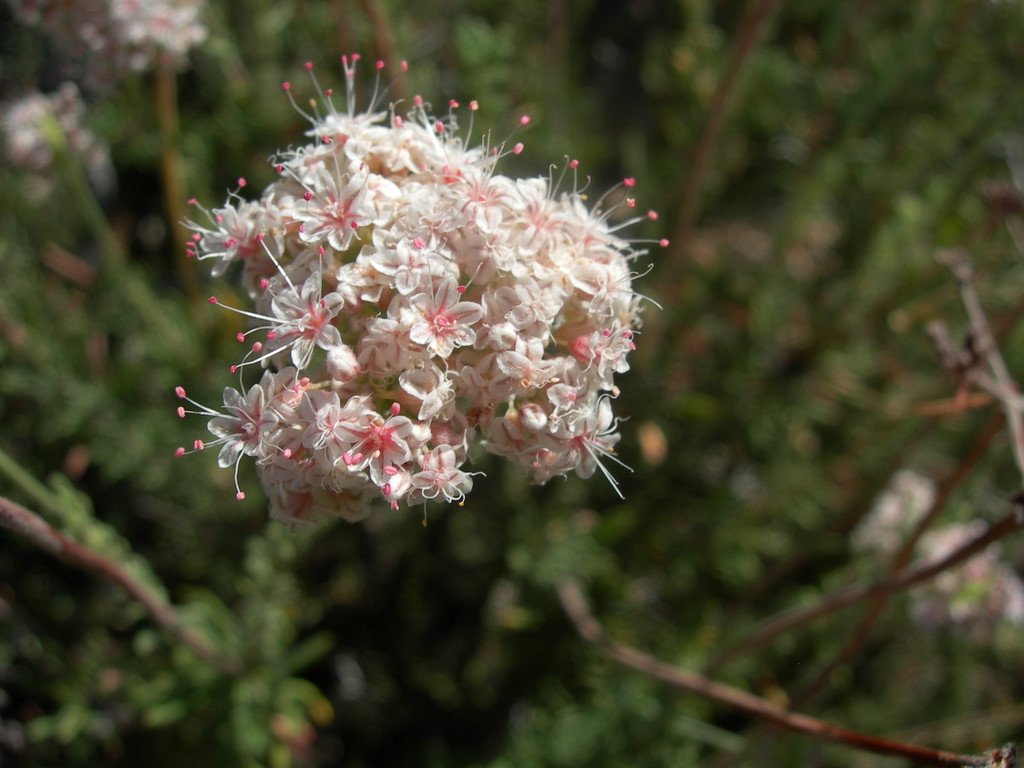Flattop Buckwheat
Eriogonum fasciculatum
Family: Polygonaceae
Evergreen shrub, variable in size, often 3’ high x 4’ wide, but can get bigger. Pink and white flowers occur late spring into summer, though they can occur in other warm weather times.
Plant in full to part sun, moderate water with good drainage, hardy to 15° F. Sometimes post-bloom plants can look a little rough, especially in containers. This is summer dormancy and you don’t want to alter your normal watering schedule—don’t cut back or increase your watering, the plant will come back.
Photo by Jim Boone, iNaturalist
Eriogonum fasciculatum on SEINET
Desert buckwheat is a larval food plant for several butterflies, notably the Bernardino dotted-blue (Euphilotes bernardino), lupine blue (Plebeius lupini), Mormon metalmark (Apodemia mormo), and Behr's metalmark (A. virgulti). Probably the butterfly most commonly seen with the species is the nut-brown hairstreak (Satyrium saepium), which frequents plants in full flower. Many bees, butterflies, and other pollinators rely on the nectar of this plant. Desert tortoises love this plant.
Used for diarrhea, as an emetic, against witchcraft, for heart medicine, to help heal wounds, for hoarseness, for stomachaches and the wood was used to pierce ears.
Eriogonum is from Greek erion, wool and phyllon, leaf, fasciculatum is derived from Latin word for bundles. There are 244 species of Eriogonum mostly in the Americas.
Found on dry rocky slopes from 1,000-4,500 ft. in southern California, Arizona, southern Nevada, Utah; south into Sonora and Baja California.
There are a number of distinct varieties. Several varieties occur in Arizona, but the most common you’ll find (and the one growing in the mountains around us in both Tucson and Phoenix) is E. fasciculatum var. polifolium:
Eriogonum fasciculatum var. polifolium — Desert buckwheat, mountain buckwheat, gray-leaved California buckwheat
Eriogonum fasciculatum var. emphereium —endemic to western El Vizcaíno Biosphere Reserve in Baja California Sur
Eriogonum fasciculatum var. fasciculatum — Coastal California buckwheat, autonymous variety
Eriogonum fasciculatum var. flavoviride — eastern Mojave buckwheat, bright green California buckwheat
Eriogonum fasciculatum var. foliolosum — red topped buckwheat

Typical shape of desert buckwheat, photo by Jay Chamberlain on iNaturalist

Flower detail, photo by Ries Lindley, SEINET

Plants after blooming. The brown seeds can be pruned off or allowed to just fall off. Photo by Emily Sluiman, iNaturalist

